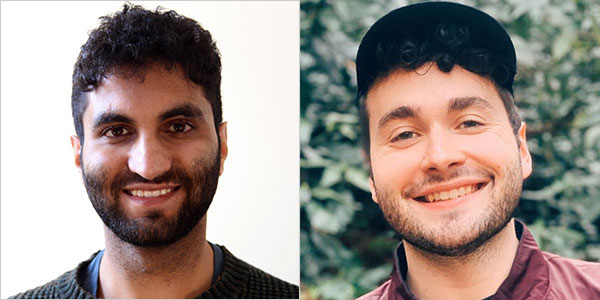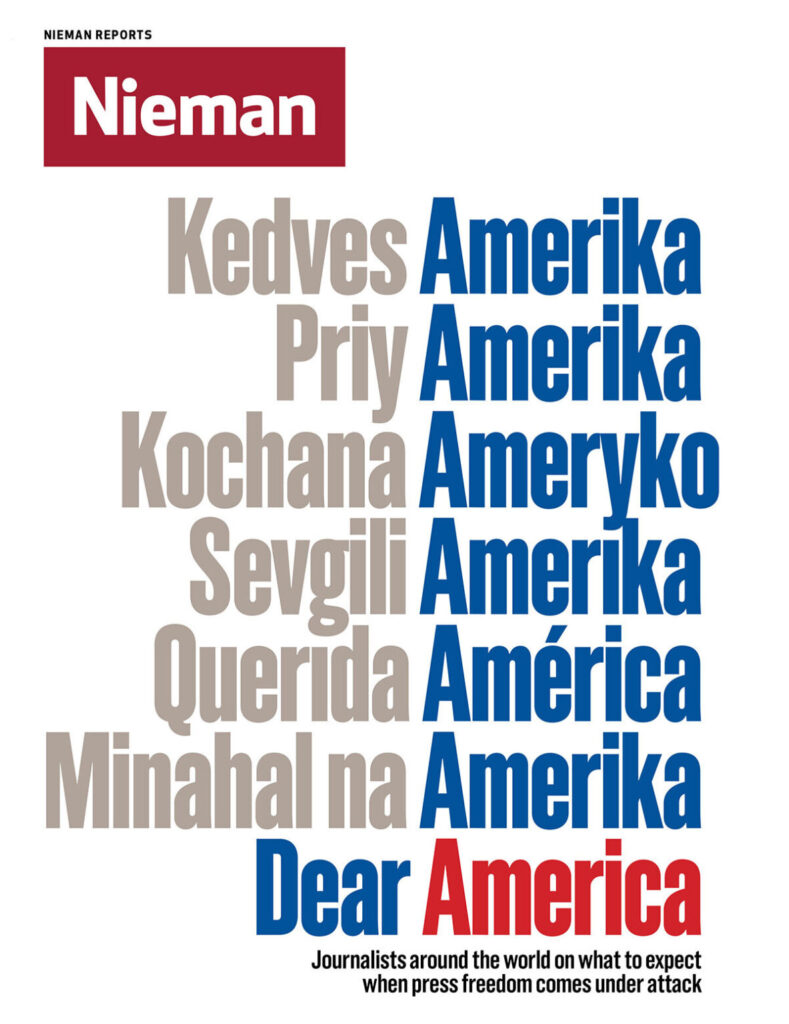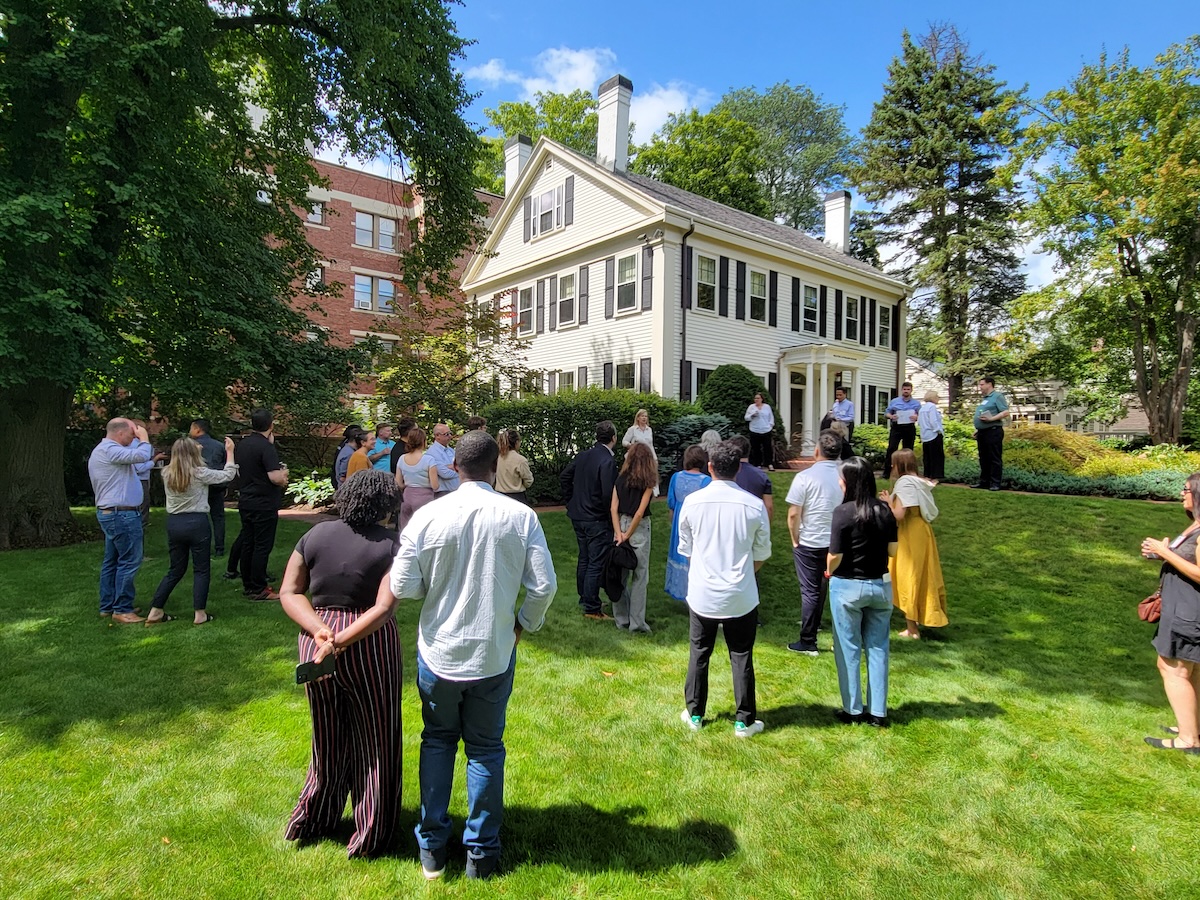Nieman Journalism Lab

For the past 16 years, the Nieman Journalism Lab has served as an essential resource for a worldwide audience of journalists, academics and analysts looking for original reporting, research and commentary on the rapidly changing news industry. The Lab continues to provide incisive reporting about the future of news, innovation and best practices in the digital space.

This year, Nieman Lab expanded to a full-time team of seven: Andrew Deck joined us from Rest of World as a staff writer focused on the intersection of generative AI and journalism and Neel Dhanesha came on board as a general staff writer; he was previously at Heatmap News. Other Lab staff members are Laura Hazard Owen, editor; Sarah Scire, deputy editor; Joshua Benton, senior writer; Sophie Culpepper, a staff writer focused on local news in the U.S.; and Hanaa’ Tameez, a general staff writer.
In March, the website journalism.co.uk called Nieman Lab “the bible of the news and media industry.” Our daily and weekly newsletters together have more than 70,000 subscribers. We also have over 515,000 followers across social platforms and can be found on Bluesky, Threads, Mastodon, LinkedIn, Facebook, WhatsApp, and X.
Nieman Lab stories are regularly cited in leading publications including, this year, The New York Times, The Washington Post, The Guardian, The New Yorker, The Atlantic, CNN, Bloomberg, Axios, The Daily Beast, Politico, Adweek, Engadget, Futurism, Yahoo, kottke.org, Business Insider, Vox, The Markup, Futurism and The Harvard Gazette.
In 2024, Nieman Lab journalists attended or spoke at events including the International Symposium on Journalism, ONA, the LION Summit, the International Journalism Festival and Washington State University’s Murrow Symposium. They also took part in events at the Gabriel Garcia Marquez Foundation and the University of Michigan.
This sampling of the top stories Nieman Lab published this year illustrates the breadth of topics covered:
- “This is just weird”: BuzzFeed News’ former royals reporter on Kate Middleton, Palace PR, and distrust in the media
- ChatGPT is hallucinating fake links to its news partners’ biggest investigations
- Is The New York Times’ newsroom just a bunch of Ivy Leaguers? (Kinda, sorta.)
- 10 years after Serial: Nieman Lab looks at crime news now
- To preserve their work — and drafts of history — journalists take archiving into their own hands
- Google tests removing the News tab from search results
- The Salt Lake Tribune, profitable and growing, seeks to rid itself of that “necessary evil” — the paywall
- The Houston Landing’s newsroom is “blindsided” by the firing of its top editor and a star reporter
- I’m a journalist and I’m changing the way I read news. This is how.
- What’s in a byline? For Hoodline’s AI-generated local news, everything — and nothing
- What would Project 2025 do for (or to) journalism?
- Six months in, journalist-owned tech publication 404 Media is profitable
- “Economic headwinds”? No, The Messenger’s flop is the result of one man’s blindness to his own bad ideas
- The LA Times lays off 115 people, with the De Los and Washington, D.C. teams especially hard-hit
- Why does the Wichita Beacon keep losing reporters?
- When the winner’s name isn’t enough: How the AP is leaning into explanatory journalism to call races
The year ended, as it has each year since 2011, with a collection of predictions for journalism, written by a diverse group of smart digital thinkers and doers.
Nieman Reports

Throughout 2024, Nieman Reports provided coverage of critical challenges confronting journalists and journalism. Key areas of focus included the impact of the wars in Gaza and Ukraine, assaults on global press freedom and heightened threats to media workers’ safety worldwide. In the U.S., news organizations also faced new challenges during and after the presidential election cycle amid an erosion of democratic norms and media freedom.
Despite growing legal, financial and security risks, journalists have responded with resilience and innovation — with some establishing new media outlets or setting up newsrooms in exile to evade press crackdowns in their home countries.
Nieman Reports has been documenting these changes in the media landscape through original features, analysis and timely expert interviews both on our website and in our quarterly print publication.

Our Winter/Spring 2024 cover package focused on the unprecedented number of journalist fatalities during the ongoing Israel-Hamas war, in which 141 media workers have been killed to date. John Daniszewski, vice president for standards and editor-at-large at The Associated Press, wrote the issue’s cover story, training a spotlight on how the war in Gaza is part of an alarming and growing trend of the lack of accountability for killers and jailers of journalists. The cover package included obituaries of the media workers killed in the conflict; our editorial team worked with local fixers and a fact-checker to gather and confirm details of the reporters’ lives and obtain photographs from family members. Despite internet outages and the threat of bombardment facing our sources, the Nieman Reports editorial team was able to secure communication with our interviewees, which was crucial to the story.
Additionally, the issue contained feature stories on the state of journalism around the world. Valentine Faure wrote about billionaire Vincent Bolloré acquiring major media networks in France and pushing political discourse to the right. Jon Marcus, a higher-education editor at The Hechinger Report, covered the rise of social media skills being taught in journalism schools, and Pratika Katiyar reported on student journalists playing a key role in engaging Gen Z voters ahead of the 2024 election.
Laura Krantz McNeill published her research on crucial skills media leaders should adopt in order to better serve their employees and audiences. Jared Schroeder, an associate professor at the Missouri School of Journalism, reported on how pending U.S. Supreme Court cases on social media could negatively impact the media industry. x

Nieman Reports’ Summer 2024 issue explored the role of the press covering the 2024 presidential election. Our cover story by John Harwood, a 1990 Nieman Fellow and longtime political journalist, examined the tension between maintaining journalistic objectivity and the need to hold political figures accountable when they undermine press freedoms.
This issue also covered the increasing importance of archiving the records of media publications. Gabe Bullard, a 2015 Nieman Fellow, wrote about the challenges of archiving online content of digital outlets facing sudden shutdowns. Ann Cooper investigated the AP’s 20-year effort to set up the news agency’s archives and preserve the organization’s history.
Stefania D’Ignoti reported on the Italian government’s attacks on journalists through lawsuits, wiretaps and other forms of surveillance. Sheikh Sabiha Alam, a 2023 Nieman Fellow, wrote about Bangladesh’s draconian crackdown on journalists and how it is affecting the country’s political cartoonists.

Our Fall 2024 cover story, assembled in the wake of the election of Donald Trump, expanded further on the theme of media freedom under threat. Nine journalists – almost all of them Nieman Fellows – in democratic nations where press freedom has been under sustained attack advised their colleagues in the U.S. on how to prepare for the fight to keep independent journalism alive. The “Dear America” letters came from such countries as India, Hungary, Peru, and Zimbabwe.
In the same issue, Ann Cooper wrote about Russian journalists in exile creating the Russian Independent Media Archive. The initiative, co-founded by Russian American journalist and 2004 Nieman Fellow Masha Gessen, is safeguarding the archives of over 100 Russian media outlets following Vladimir Putin’s 2022 crackdown on the independent press.
A feature story by Puja Changoiwala highlighted the struggles of Dalit journalists in India, while Gabe Bullard reported on the challenges facing National Public Radio member stations across the U.S. in the aftermath of the Covid-19 pandemic. Mark Fisher chronicled the tumult at The Baltimore Sun under its new owner, David Smith, who purchased the newspaper in early 2024. Marigo Farr reported on the state of entry-level journalism and the plight of newcomers who, in recent years, have struggled for a foothold in an industry beset by layoffs, low wages and dwindling opportunities for full-time staff jobs.
In addition to our quarterly magazine, Nieman Reports regularly publishes online-only think pieces, articles and essays. Some of the top stories from 2024 include:
- A Moment of Deep Sorrow on the U.S.-Mexico Border
- Let’s Retire the “Leaving Journalism” Fallacy
- The Long, Slow Death of the Newspaper Editorial
- News Organizations Are Leaving Twitter. What About You?
- Three Months in a Zimbabwean Prison Couldn’t Stop Me from Reporting on Corruption
- A History of the AR-15
- The Battle Over Using Journalism to Build AI Models is Just Starting
- The Story Behind the Execution of AP Reporter Joseph Morton During WW2
- ‘I’ve Never Experienced This Level of Silence’
- After the Flood
Nieman Reports saw steady growth on its social channels in 2024 under the direction of the Nieman Foundation’s digital and audience engagement editor, Adriana Lacy. In addition to its print subscribers, Nieman Reports has more than 38,500 followers on X, an increase of 6,000 followers from the previous year, and another 7,100 followers on Facebook. To further engage online audiences, we rebooted our monthly photojournalism column, AfterImage; prioritized online-only Q&As; and added more GIFs/animations, audiograms and data visualizations to accompany our stories.
The staff that produced Nieman Reports in 2024 included editor Laura Colarusso (who left in October to become editor of CommonWealth Beacon); assistant editor Megan Cattel; contributing editors Henry Chu and Samantha Henry; and publisher Ann Marie Lipinski with design by Dan Zedek, a Boston-based independent designer.
Nieman Storyboard

Nieman Storyboard continued to explore outstanding narrative journalism and nonfiction storytelling in 2024 through its regular features, including Story Annotations, Story Craft, Strictly Q&A and Why’s This So Good? Storyboard also publishes interviews with writers, coverage of literary events, and posts on narrative craft from veteran storytellers.
During the year, journalist, author and teacher Kim Cross shared her interview techniques for narrative stories in an informative four-part series. Storyboard contributors covered the 2024 Power of Narrative conference at Boston University in March, and San Francisco-based reporter Carly Stern explored the ins and outs of effective editing in a series of articles.
A fond farewell and a new beginning

Longtime Storyboard editor Jacqui Banaszynski, who guided the site and shared her humor, expertise and invaluable insights since 2018, left the post in the fall, saying: “I am stepping away from the editor’s chair, a little more than six years and 325 Friday newsletters after the journalism gods smiled and granted me the gig. Like every turn in my career, it was unexpected and proved the best kind of challenge — one in which I continued to learn about both the craft and myself.”
Nieman Curator Ann Marie Lipinski said: “Jacqui has been an inspiration to thousands of journalists who have followed her writing on narrative journalism. We are grateful for her guidance and will miss her wit and storytelling.”
Nieman Deputy Curator Henry Chu stepped in after Jacqui’s departure, posting new articles and writing Storyboard’s weekly newsletter, which reaches more than 13,0000 subscribers.
Storyboard favorites
A few of the most popular stories this year include:
- How to stop “performing” and write as only you can write
Author, journalist and narrative teacher Steve Almond offers self-aware writing advice in a new "DIY manual for the construction of stories" - How a business reporter approached a story about sex-content influencers
Drew Harwell peeked behind the screen of OnlyFans, a social media sex site, for The Washington Post's “creator economy” series - The power of the pun, from Shakespeare to Walter Cronkite to Roy Peter Clark
How a bit of word play launched Clark’s career as the renowned writing teacher at the Poynter Institute and author of 20 books on writing
Another important story was “Finding a quiet voice in the center of America’s screaming immigration debate,” a story annotation by Trevor Pyle of Ruby Cramer’s Washington Post profile of a small-town official in Massachusetts caught in the crossfire of fear, anger and blame over asylum-seekers.
Other stories that attracted attention in 2024 include:
- 2024 Power of Narrative: Double the power of your story with a braided structure
In a long feature story, two related or resonant threads can be woven to make a piece that is both complex and clear - 2024 Power of Narrative: How to bring empathy to your reporting
Separating empathy from advocacy, and practicing it as a tool of better listening and more complete stories - 2024 Power of Narrative: “Be human first” when covering trauma and children
From pool drownings to school shootings, John Woodrow Cox shares lessons on reporting violence through the voices of children (and others) - A journalist, a boy, and a surprising literary gift
What a New York Times editor’s father-son trip can teach us about personal essay writing - David Grann Part 1: A deep-dive into “The Wager”
The New Yorker writer and bestselling author — who says he's not a “natural writer” — shares the research and writing process behind his latest book - 13 ways to consider an interview
A magazine writer and editor shares real-life lessons from 50 years of interviewing: It's not a conversation and you are not a supplicant - How investigative master Seymour Hersh broke the story of the My Lai massacre
A round-about tip, a dogged pursuit and some creative tactics made the career of a young reporter and helped end a war - Effective editing: “I’m in service of you, the writer”
Author Glenn Stout has built a following as a freelance editor, giving writers confidence, solutions and sometimes channeling their voice - How a reporter prepped to understand A.I. and the man who helped invent it
New Yorker Ideas Editor Joshua Rothman brushed up on algebra and spent four days on a private island to profile the “godfather” of A.I. - How an arts reporter unraveled a controversial and opaque family art dynasty
Rachel Corbett hunted back through generations of art deals, international laws and tax havens to explore suspicions about a family's hidden fortune

